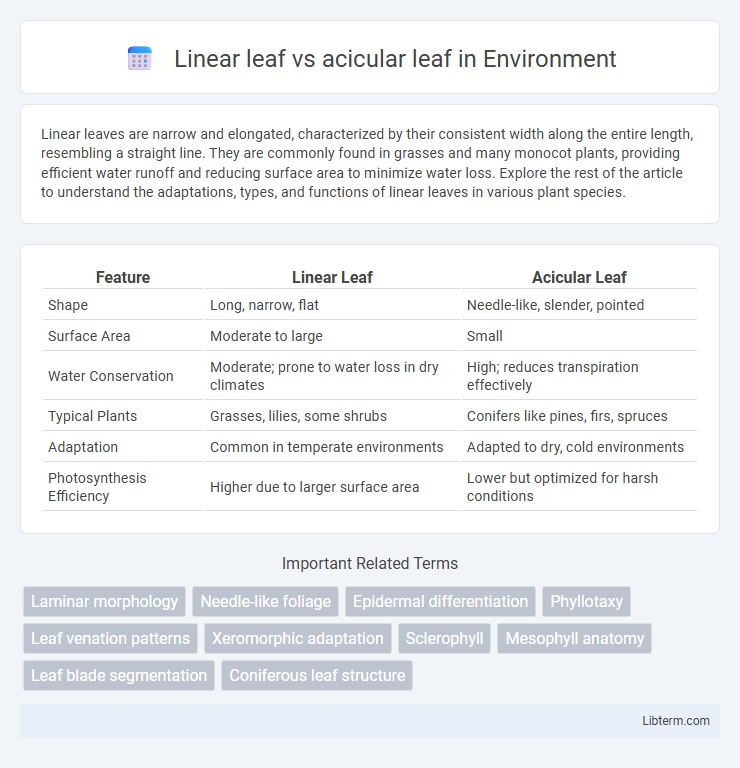Linear leaves are narrow and elongated, characterized by their consistent width along the entire length, resembling a straight line. They are commonly found in grasses and many monocot plants, providing efficient water runoff and reducing surface area to minimize water loss. Explore the rest of the article to understand the adaptations, types, and functions of linear leaves in various plant species.
Table of Comparison
| Feature | Linear Leaf | Acicular Leaf |
|---|---|---|
| Shape | Long, narrow, flat | Needle-like, slender, pointed |
| Surface Area | Moderate to large | Small |
| Water Conservation | Moderate; prone to water loss in dry climates | High; reduces transpiration effectively |
| Typical Plants | Grasses, lilies, some shrubs | Conifers like pines, firs, spruces |
| Adaptation | Common in temperate environments | Adapted to dry, cold environments |
| Photosynthesis Efficiency | Higher due to larger surface area | Lower but optimized for harsh conditions |
Introduction to Leaf Morphology
Linear leaves exhibit a long, narrow shape with parallel margins and uniform width, commonly found in grasses like wheat and barley. Acicular leaves, characterized by their needle-like shape with a pointed tip and reduced surface area, are typical of conifers such as pine and spruce. These distinct leaf morphologies influence photosynthetic efficiency and adaptation to environmental conditions, with linear leaves maximizing sunlight capture and acicular leaves minimizing water loss.
Defining Linear Leaves
Linear leaves are characterized by their elongated, narrow shape with parallel sides and a consistent width throughout, commonly found in grasses and some monocots. These leaves optimize surface area for light absorption while minimizing water loss, an adaptation frequently seen in dry or windy environments. Unlike acicular leaves, which are needle-like and sharply pointed, linear leaves maintain a flat, ribbon-like form that supports efficient photosynthesis and transpiration control.
Characteristics of Acicular Leaves
Acicular leaves are needle-like, typically narrow and slender with a pointed tip, which reduces surface area and minimizes water loss, making them highly adapted for coniferous trees in dry or cold environments. These leaves have a thick cuticle, sunken stomata, and a dense arrangement of vascular tissues to conserve moisture and withstand harsh conditions. Unlike linear leaves that are flat and more flexible, acicular leaves provide increased durability and optimized photosynthesis during prolonged winters.
Key Differences: Linear vs Acicular Leaves
Linear leaves are elongated and narrow with parallel sides, commonly found in grasses and some monocots, while acicular leaves are needle-shaped, slender, and pointed, typical of many conifers such as pines and firs. Linear leaves usually have a flat and broad surface, facilitating photosynthesis over a larger area, whereas acicular leaves have a reduced surface area to minimize water loss and withstand harsh environmental conditions. The structural adaptation of acicular leaves includes a thick cuticle and sunken stomata, contrasting with the simpler anatomy of linear leaves.
Botanical Examples of Linear Leaves
Linear leaves, characterized by their long, narrow shape with parallel sides, are commonly found in grasses such as wheat (Triticum aestivum) and ryegrass (Lolium perenne). These leaves optimize sunlight capture while minimizing water loss, making them well-suited for environments with dry or windy conditions. In contrast, acicular leaves, like those of pine trees (Pinus spp.), are needle-like and typically adapted for cold or nutrient-poor habitats.
Botanical Examples of Acicular Leaves
Acicular leaves are slender, needle-like structures commonly found in coniferous plants such as pines (Pinus spp.), firs (Abies spp.), and spruces (Picea spp.), characterized by their narrow, pointed shape adapted to reduce water loss in cold or dry environments. Unlike linear leaves, which are elongated and flat as seen in grasses (Poaceae) or lilies (Lilium spp.), acicular leaves have a cylindrical or slightly flattened cross-section enhancing their rigidity and minimizing surface area. These botanical adaptations enable conifers to thrive in diverse climates by optimizing photosynthesis while conserving moisture.
Adaptations and Ecological Roles
Linear leaves, characterized by their long, narrow shape with parallel veins, reduce water loss and withstand strong winds, making them ideal for arid and open environments such as grasslands and deserts. Acicular leaves, needle-like and often covered with a thick cuticle and sunken stomata, are adapted to minimize transpiration and conserve moisture, enabling conifers to thrive in cold, dry, and nutrient-poor habitats like boreal forests. Both leaf types optimize photosynthesis under stress conditions and contribute to their ecosystems by supporting species adapted to extreme climatic conditions and influencing fire regimes and soil nutrient cycling.
Identification Tips for Linear and Acicular Leaves
Linear leaves are long and narrow with parallel sides, typically flat and resembling a straight strip, commonly found in grasses and many monocots. Acicular leaves are needle-like, slender, and pointed, often cylindrical or slightly flattened, characteristic of pine, fir, and other coniferous species. Identification tips include examining leaf shape and cross-section: linear leaves appear flat and strap-shaped, while acicular leaves are thin, pointed, and often needle-shaped with a rounded or angular cross-section.
Importance in Plant Classification
Linear leaves, characterized by their long, narrow shape with parallel sides, and acicular leaves, which are needle-like and typically found in conifers, serve as critical markers in plant classification. These leaf types provide essential morphological traits that help taxonomists distinguish between angiosperms and gymnosperms, contributing to the identification of plant families such as Poaceae with linear leaves and Pinaceae with acicular leaves. The presence of these distinct leaf structures aids in ecological adaptations, influencing classification systems based on evolutionary relationships and habitat specialization.
Conclusion: Choosing Between Linear and Acicular Leaves
Choosing between linear and acicular leaves depends on environmental adaptation and plant function; linear leaves, typically broader and flat, optimize photosynthesis in moderate climates, while acicular leaves, needle-like and narrow, reduce water loss and withstand cold or dry conditions. Plants with linear leaves often thrive in temperate regions with ample water availability, whereas species bearing acicular leaves are suited for arid or alpine environments. Understanding these morphological differences informs ecological strategies and horticultural decisions for plant cultivation and habitat restoration.
Linear leaf Infographic

 libterm.com
libterm.com